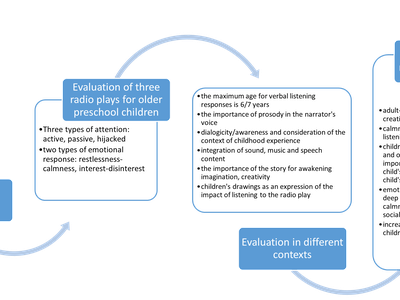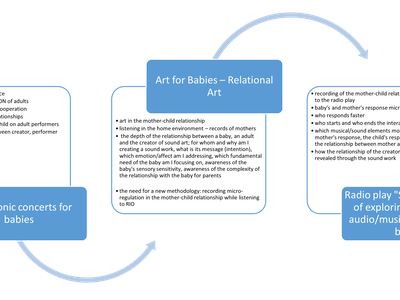The subject of evaluating artistic radio works for the youngest is a significant challenge. Firstly, because it addresses the most fundamental questions about the needs of children and the meaningfulness of creating artistic radio works specifically for this population—essentially, the question of purpose. The second challenge is the selection of criteria for evaluation, and the subsequent challenge is to design an appropriate methodology for assessing the effects of audio works on infants and toddlers.
We approached these challenges on multiple levels simultaneously. Interdisciplinary teams of experts in psychology, neuroscience, music education, and didactics, as well as artists, were formed. They collaboratively developed artistic works and tested them in various listening contexts.
The central evaluation group consisted of three experts: a developmental psychologist and psychotherapist, an expert in the psychology of music and educational psychology, and an expert in music education and didactics. This group established the basic evaluation methodology based on consultations with a media psychologist and the editor of children's and youth programs at RTV Slovenia, who has extensive experience in systematically monitoring the responses of the youngest to media content. Before planning developmentally appropriate evaluation approaches for radio works for the youngest, we thoroughly examined foreign literature in this field and examples of best practices.
It is essential to emphasize that this field is poorly researched even internationally. Throughout the entire project, we continuously refined and modified the methodology based on experiences at each action step of the project. Evaluation criteria and recommendations for creating radio works for the youngest were sharpened throughout the project, as diverse effects and potentials of this type of art were revealed.
Research Objectives: The goal of the action research was the same as that of the project: creating sound art for infants, toddlers, and vulnerable groups. The objectives included a theoretical overview of sensitizing children and adults through musical and sound art, and the importance of auditory sensory perception for the experience, development, and emotional regulation of the youngest. Additionally, they focused on researching sensitization through radio artistic works, developing an evaluation methodology, implementing the evaluation of artistic events, using evaluation results in the planning and creation of artistic events in the steps of action research, and presenting research results.
To achieve these goals, we first sought theoretical foundations to understand the importance of sound and music, as well as methodology to determine the effects of sound and music on the development and experience of the youngest. Because the creation field for children under 3 years old is still very new and unexplored, with few existing works, there are also no established criteria for in-depth evaluation of these works and their contribution or impact on development and experience. Through the project, we aimed to shape a methodology for the evaluation and contribute new insights into the field of creating sound art for the youngest. We were particularly interested in the role of sound in a child's experience, and which characteristics of sound and music art have the greatest impact in this context.
We evaluated the resulting works step by step, developing evaluation methods for each work and group for which the work was created. Through ongoing evaluation of the effects of individual sound and radio artworks on listeners (infants, toddlers, and their caregivers), we determined which elements of these works most strongly influenced the attention and interest of infants and also triggered interest and attention from adults toward the child. Simultaneously, after each step of the research, we incorporated new findings into the planning and preparation of the next cycle of events for infants, toddlers, and vulnerable groups.
EVALUATION OF ARTISTIC AUDIO WORKS FOR INFANTS AND TODDLERS_RESEARCH WORK

